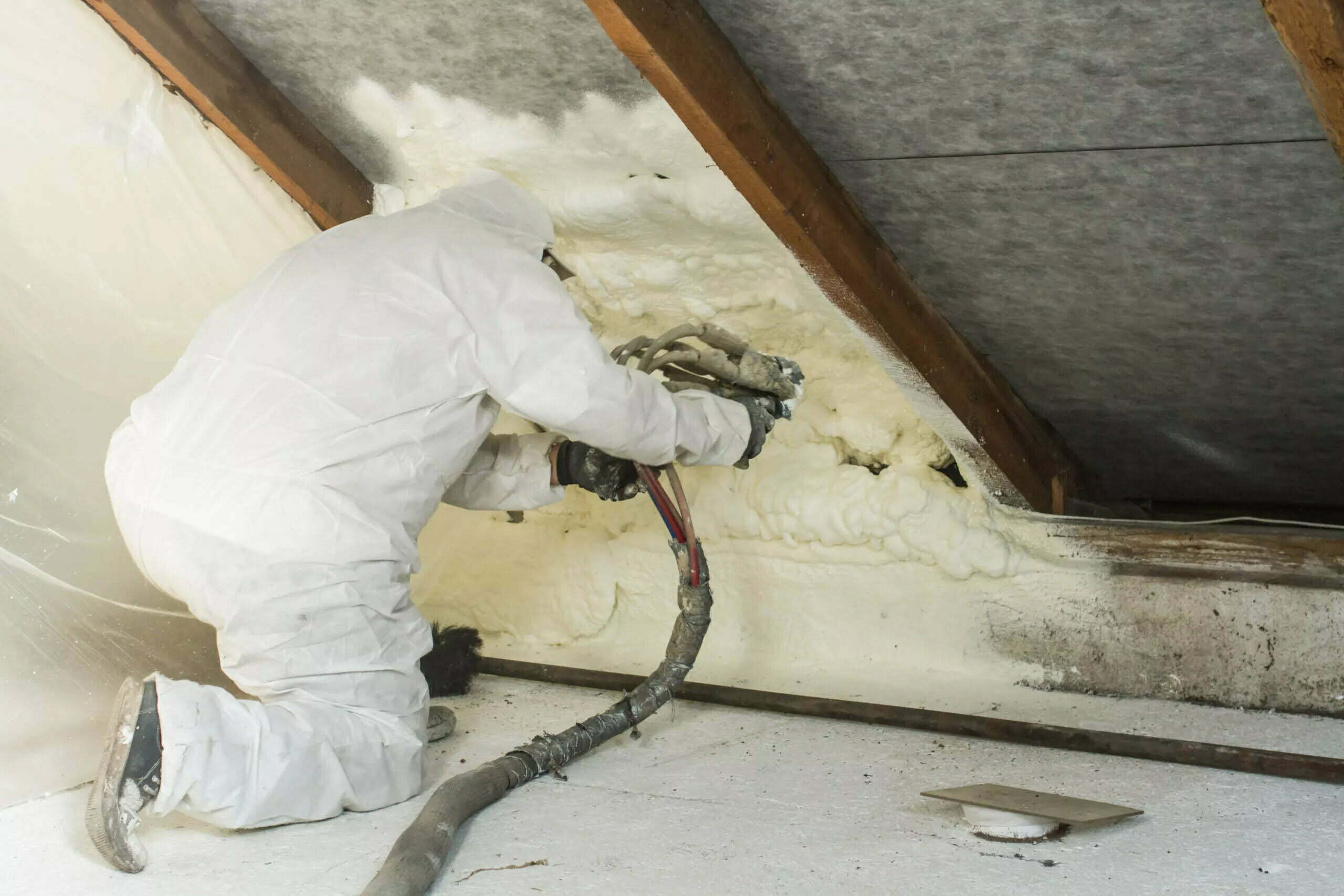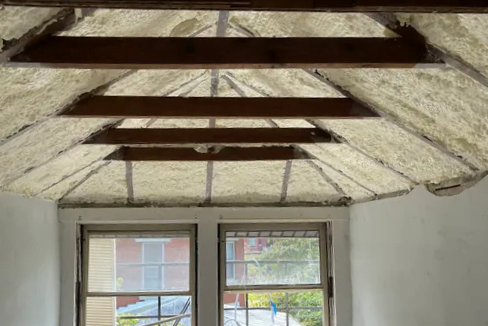Installing spray foam insulation under your roof can provide superior insulation, durability, and energy savings compared to traditional materials. However, there are some things to consider. When properly applied, spray foam forms a seamless barrier that seals air leaks and resists moisture. Let’s learn all about the proper application, common concerns, and the advantages of a spray foam insulation roof.
Understanding Spray Foam Insulation
Before delving into the specifics of how spray foam insulation benefits roofs, let’s start with the basics of understanding this unique material.
What is Spray Foam Insulation?
Spray foam insulation is a two-part liquid material that expands and hardens when combined, forming rigid foam plastic. The liquid components consist of isocyanate and a polyol resin blend. These are kept separate until applied at the job site with a spray gun.
When the two solutions are mixed, they undergo a chemical reaction that causes the liquid to rapidly expand 30-60 times its original volume and cure into insulating foam. The resulting foam can be applied to fill cracks, gaps, and spaces as a thermal and moisture barrier.
Spray foam insulation is available in two main formulations:
- Open cell spray foam: has a permeable, absorbent structure. It offers insulation, air sealing, and sound dampening.
- Closed cell spray foam: has a dense, rigid structure with low water absorption. It provides structural enhancement, insulation, and vapor control.
Some key differences between open-cell and closed-cell foam include the following:
- Open-cell foam is more affordable but provides less R-value per inch. Closed cell offers maximum R-value but costs more.
- Closed cell insulation adds rigidity and strength, while the open cell is flexible and compressible.
- Open cell foam is vapor permeable, allowing some drying potential. Closed cell foam acts as a vapor barrier.
- Acoustic dampening is superior to open-cell foam. Closed-cell foam has minimal sound-absorbing properties.
The right foam type depends on the application requirements and building assembly. Professional installers determine the optimal formulation.
How Does Spray Foam Insulation Work?
Spray foam insulation works in several ways to insulate, seal, and add rigidity:
- The expanding foam fills building cavities, small cracks, and spaces that would otherwise allow air leakage. This air sealing prevents drafts and regulates temperature.
- The cured foam forms a continuous barrier that resists heat flow and slows heat loss or gain.
- Closed cell foam contains tiny separated air pockets that impede conductive and convective heat flow.
- The rigidity of cured foam adds structural stability to walls, roofs, and other building components.
- Foam can adhere tightly to other materials to provide additional mechanical anchoring.
Combined, these properties make spray foam a high-performance insulation solution. The liquid-to-foam expansion process allows it to insulate irregular shapes and gaps that other insulations cannot effectively seal. This makes spray foam ideal for attics, crawl spaces, and old hard-to-insulate buildings.
The Advantages of Spray Foam Roof Insulation
Applying spray foam insulation to your roof provides a range of attractive benefits:
Energy Efficiency: A Green Insulation Option
Spray foam is one of the most efficient insulation materials available. According to the Department of Energy, it can provide over 40% better insulation than traditional materials. This energy efficiency comes from spray foam’s continuous coverage, air sealing properties, and high R-value of 3.5-7.4 per inch.
Unlike fiberglass, spray foam prevents heat transfer and air leaks, spray foam can significantly cut heating and cooling costs year-round. The reduction in energy demand also has environmental benefits. EPA studies have shown spray foam insulation can reduce a home’s carbon footprint by up to 14%.
Durability and Lifespan of Spray Foam Roof Insulation
Properly installed spray foam is exceptionally durable. It resists moisture, mold, mildew, rotting, and pests. Closed-cell foam is also rigid and structurally strong. These properties allow spray foam insulation to protect roofs for decades, outlasting many other materials.
Spray Foam Insulation’s Contribution to Structural Stability
The rigid matrix formed by cured foam makes it function not only as insulation but also as reinforcement. Adding spray foam to roof systems stiffens the assembly, providing enhanced wind uplift resistance and preventing sagging. This structural boost improves durability and can allow the reduction of other framing components in the roof.
Foam adhesion to the roof deck and frames also strengthens the structure through composite action. These structural benefits make spray foam ideal for both retrofits and new construction.
Application of Spray Foam Insulation on Roofs
When it comes to installing spray foam on your roof, proper application is key to realizing the benefits. Here are some best practices:
The Process of Installing Spray Foam Insulation for Roofs
Spray foam roofing insulation is typically applied directly to the interior surface of the roof deck and under the rafters/trusses. The process generally involves:
- Cleaning and prepping the roof deck and framing components.
- Removing and disposing of the existing fiber insulation SG
- Masking and protecting any areas not receiving foam.
- Accessing the attic and roof structure.
- Identifying any moisture issues, air leaks, or gaps to target.
- Applying primer to enhance adhesion as needed.
- Mixing and spraying foam using special equipment. Multiple passes create the desired thickness.
- Trimming excess foam once cured and removing masking/protection.
- Inspecting for uniform coverage and adhesion.
The foam expands to fill voids, seal cracks, and form a solid barrier. A typical application is 1-3 inches thick of closed-cell. Regarding the roof spray foam, open-cell is typically 3.5″ – 6″ thick. The process causes little disruption to the building below.
Proper spray technique is important to achieve a uniform foam layer with full adhesion. The foam should be applied slowly and methodically with a steady back-and-forth motion and occasional pauses. Rushing the spraying process can result in uneven curing, cold joints, or lack of fusion between passes.
Monitoring temperature and humidity is critical, as certain conditions can interfere with proper foam expansion and bonding. Professional installers meticulously monitor all these factors for optimal application.
The Importance of Hiring Professionals for Spray Foam Roofing Insulation
While spray foam kits are sold for small DIY projects, it is highly advisable to hire professional spray foam contractors for whole-roof spray foam insulation. Qualified installers have extensive experience and specialized equipment to ensure proper application.
Professionals can accurately calculate the required foam type and thickness needed for your roof assembly and climate conditions. They also implement best practices for preparation, spray technique, trimming, and cleanup. This expertise is essential to achieve expected insulation performance and avoid potential moisture issues.
DIY spray foam application often yields inconsistent coverage and thickness that can leave energy-losing gaps. Professional crew training and quality control are critical to robust roof insulation.
Cost-Effectivity of Spray Foam Insulation for Roofs
The per-square-foot cost of both material and installation for spray foam insulation is greater compared to traditional batt insulation. However, given the superior energy savings and longevity of spray foam, the return on investment over the roof’s life makes it extremely cost-effective.
Based on a preliminary calculation, the initial expenditure on spray foam insulation may be recovered through energy savings within just 5 years for a typical residence. Unlike the necessity for re-insulating every 10-15 years, the prolonged lifespan of spray foam, exceeding 30 years, leads to substantial cost savings.
The added benefits like structural enhancement, moisture resistance, and reduced air leakage provided by spray foam should also be factored in when evaluating the price. The price is worthwhile, given the extended roof life, energy savings, and performance.
Common Concerns and Solutions Regarding Spray Foam Insulation
While the benefits are substantial, some homeowners have reasonable concerns when considering spray foam insulation. Let’s explore some common questions and answers:
Safety and Environmental Considerations of Using Spray Foam
Spray foam insulation provides a safe, non-toxic interior environment when applied correctly. However, the chemicals present require careful handling:
- Installers should utilize personal protective equipment to avoid inhaling fumes.
- Proper ventilation must be implemented during and after application.
- Any excess foam dust created during trimming must be contained and disposed of safely.
- Foam chemicals require specialized disposal methods and should not be poured down drains.
With prudent procedures, spray foam is very safe for building occupants and installers.
Solving Potential Problems with Spray Foam Insulation on Roofs
There are solutions to a few potential problems that sometimes occur:
- Poor adhesion can be prevented with proper substrate preparation and primer use.
- Cracks or gaps in the foam can be addressed by applying a thin topcoat layer.
- Dust creation during trimming can be minimized with the right techniques.
- Any moisture issues can be resolved by identifying and fixing the source before re-applying foam.
Overall, hiring experienced professional installers is the best way to avoid any issues with your spray foam roof insulation.
Installing spray foam insulation on your roof provides superior thermal and moisture control compared to traditional insulation materials. When properly applied by professionals, the seamless coverage, air-sealing properties, and structural rigidity of spray foam can benefit your roof for decades to come. If energy efficiency, longevity, and performance are priorities for your next roofing project, be sure to consider spray foam insulation.
Trust Cincinnati RetroFoam for Spray Foam Insulation
When it comes to spray foam insulation in Cincinnati homes and buildings, there’s one company you can trust – Cincinnati RetroFoam.
As a local company rooted in Cincinnati, we understand our climate, older housing stock, and the benefits injection foam can offer. We offer top-quality open and closed-cell foam solutions to match your project. This leads to optimal energy efficiency and comfort improvements. From start to finish, you can rely on our team of seasoned professionals to implement foam insulation right.
If you’re looking to upgrade your home’s insulation with spray foam, look no further than the experts at Cincinnati RetroFoam. Our tailored solutions, outstanding service, and results you can count on make us the smart choice for foam insulation.
FAQs
How long does spray foam roof insulation last?
When properly installed, spray foam insulation can last over 30 years with minimal degradation. This is 2-3 times longer than traditional insulation.
Is spray foam worth the higher cost?
The higher upfront cost is justified by energy savings of 40% or more compared to other insulations, plus dramatically extended service life. Most see payback on investment in under 5 years.
What are the risks of moisture with spray foam insulation?
If there are leaks in the roof or walls, water intrusion can occur. While closed-cell spray foam has a degree of water resistance, it is not entirely waterproof. Prolonged exposure to water can compromise the insulation’s effectiveness.


